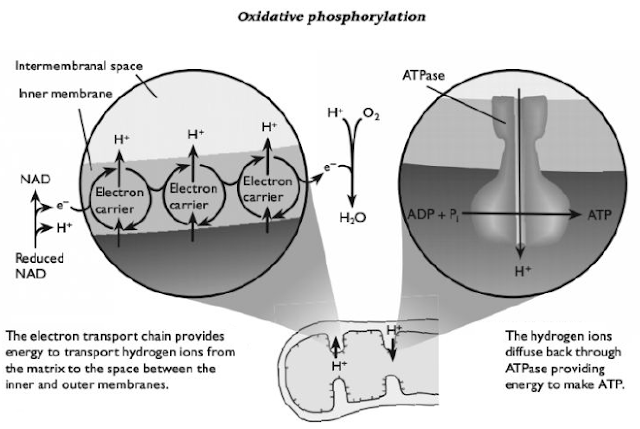In the final stage of aerobic respiration, oxidative phosphorylation, the energy for the phosphorylation of ADP to ATP comes from the activity of the electron transport chain (ETC). Oxidative phosphorylation takes place in the inner mitochondrial membrane, the cristae.
The H+ are allowed to diffuse back into the matrix through special channel proteins that work as ATPases.The movement of the H+ through the ATPases provides enough energy to cause ADP and inorganic phosphate to combine to make ATP.
At the end of the chain, the electrons reunite with the protons from which they were originally split. They combine with oxygen to produce water. This is why oxygen is required in aerobic respiration - it acts as the final acceptor for the hydrogens removed from the respiratory substrate during glycolysis, the link reaction and the Krebs cycle.
Hydrogens from reduced FAD and reduced NAD first pass to hydrogen carriers in the inner membrane and are then split are split into protons (H+) and electrons (e-).
The electrons pass along a series of electron carriers on the ETC of the inner membrane of the mitochondrion. Each of these electron carriers is at a lower energy level than its predecessor. As the electrons move along the chain, they lose energy. This energy is used to actively transport H+ from the matrix of the mitochondrion, across the inner membrane and into the space between the inner and outer membranes. This builds up a high concentration of H+ in this space.
The electrons pass along a series of electron carriers on the ETC of the inner membrane of the mitochondrion. Each of these electron carriers is at a lower energy level than its predecessor. As the electrons move along the chain, they lose energy. This energy is used to actively transport H+ from the matrix of the mitochondrion, across the inner membrane and into the space between the inner and outer membranes. This builds up a high concentration of H+ in this space.
Summary of the oxidative phosphorylation:
Syllabus: 12.1 Energy e) explain that the synthesis of ATP is associated with the electron transport chain on the membranes of mitochondria and chloroplasts 12.2 Respiration
f) outline the process of oxidative phosphorylation including the role of oxygen as the final electron acceptor (no details of the carriers are required)
g) explain that during oxidative phosphorylation: • energetic electrons release energy as they pass through the electron transport system • the released energy is used to transfer protons across the inner mitochondrial membrane • protons return to the mitochondrial matrix by facilitated diffusion through ATP synthase providing energy for ATP synthesis (details of ATP synthase are not required) |










No comments:
Post a Comment